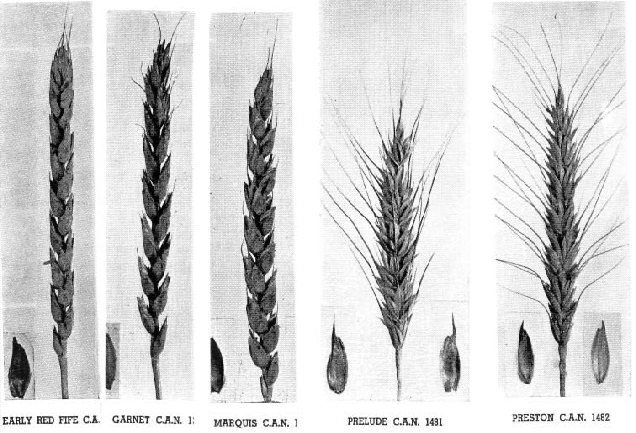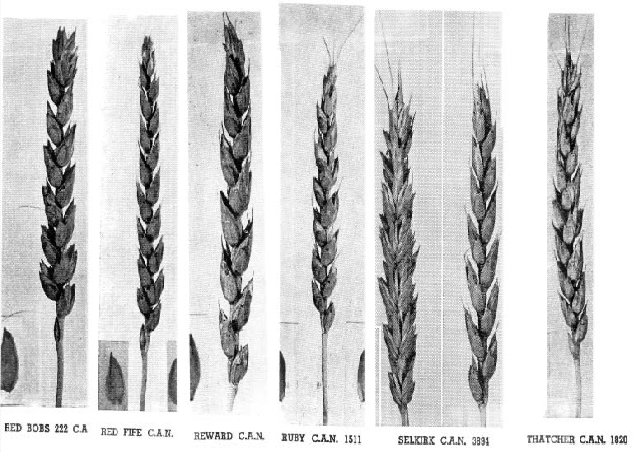Heritage wheat varieties are pre 1960 varieties that grow well without high inputs of chemicals according to Sharon Rempel. Sharon has worked with the Heritage Wheat Project since 1998 and with heritage wheats like Red Fife since 1987. The list of Canada's heritage wheat varieties and photos of these varieites include Red Fife, Ladoga, Bishop, Preston, Stanley, Hard Red Calcutta, Marquis and Thatcher. Wheat is a member of the grass family. Grassroot solutions for food security, the 100 mile diet and local food start with finding wheat varieties that are adapted to each growing area.
There are about 200,000 varieties of bread type wheats in the global shopping basket of genetic resources and yet only a few genetic lines of wheat feed the world. No wonder people have developed allergies to wheat products! We don’t need a test tube to create ‘new’ varieties, only a willingness to explore the diversity that already exists in the world.
Heritage variety conservation is a part of a broader picture of a conservation ethic that includes “farmers’ rights” as an aspect of choice of seed. There are also spiritual and cultural reasons why farmers around the world have treasured certain seeds and varieties for centuries. They taste good, produce a good yield in that area, and are adapted to that area.
A heritage wheat has been selected by farmers to suit culinary, taste, color, cultural and climatic needs from a region of the world. The crop may have developed adaptations to the stresses in the region including diseases and pests.
The variety strengths appear through the selection and adaptation process when the variety grows in the field. A heritage plant has not conceived in a lab, but was selected in the field, probably by farmers, establishing a strong ‘people, plant and place’ relationship.
Heritage wheat varieties have been discarded in favor of ‘new and improved’ hybrid varieties. since the 1960s Green Revolution farmers have encouraged to buy the new varieties as well as chemicals and fertilizers to obtain maximum yields.
There is need for ‘on farm’ variety maintenance and selection that includes farmers’ wisdom and the knowledge from their relationship with the place and the plant. Privately funded programs have replaced ‘public plant breeding’ programs in Canada and regional field stations have been closed with central facilities doing the breeding work. Winnipeg's climate is not that of Victoria, BC.
Wheat comes from the grass family Triticeae. North American bread wheat is usually Triticum aestivum and there are other ‘species’ wheats including ‘shot’ wheat, ‘durum’ pasta wheat, ‘spelt’ wheat and other kinds of wheat (see http://www.hort.purdue.edu/newcrop/proceedings1996/V3-156.html)
There is no ‘native’ wheat in North America. Wheat originated in the Fertile Crescent now known as Iran and Iraq according to Dr. N. Vavilov, and in the 1920s he called this area the ‘Center of Origin’ for wheat. With trading and migration wheat has travelled all over the world for 7000 years. Vavilov also noted a great deal of diversity of wheat in Ethiopia and called this area a ‘Center of Diversity’.
Plant scientists confirm that all members of the Triticum species contain a protein called gluten. Some people with wheat intolerance are able to tolerate spelt or other non T. aestivum wheats. However, allergy testing has not been refined enough to include testing different varieties of wheats, or consider that the growing conditions (eg. organic farming vs. chemical farming) may affect a person’s response to the grain. This is an exciting area of research where ‘heritage’ varieties may show diversity between varieties.
“Heritage” can be defined (S. Rempel) as a variety that was introduced in North America before the 1960s or is a variety that has come with a cultural group as part of their heritage. Sometimes these varieties are called ‘landraces’ or ‘traditional’ varieties or just known in the region by their local name.
When people immigrated to Canada they brought with them seeds from the varieties that did well in their homeland. They had friends mail them seeds and seeds continue to travel around the world with people. Plants and their people continue to co-evolve and travel together, despite government attempts to ‘control’ the flow and exchange of seeds through regulations. A proactive way of working with this reality would be to teach people about disease prevention and how to introduce plants and seeds safely into a new area as well as devise ways of allowing the plant to adapt to the new growing conditions.
“Heritage” varieties were selected under organic farming conditions. Heritage varieties deserve to be grown for their own sake, not just breeding material for genes to develop high input varieties.
Heritage wheat varieties are a valuable genetic resource. The loss of heritage varieties of all crops is a serious global biodiversity issue. The awareness and need for conservation of plant genetic resources (PGR) is growing but few countries have adequate ‘in situ’ or ‘ex situ’ programs for their native plant material, let alone introduced ornamental and agricultural plants. Governments expect private companies to do the conservation work and have an open policy of exchanging seeds. Companies make money and put patents on seeds so royalties are payable when using seeds.
Canadian Heritage Wheat Varieties
It is useful to take a look at the wheats that have helped put Canada on the world map as a quality wheat producer (1890s and early 1900s). When reading about the old varieties in the following list, note there are remarks. Recognize that these are ‘general’ remarks and only by field testing a variety will you find out how well it grows in your area. Provincial Agricultural texts and records are useful to see how varieties did in early years, but again remember that climatic conditions do change over time and many of the pre 1950s varieties haven’t been field tested for many years.
The old varieties usually have tall straw; straw is useful for farmers feeding animals or bedding for animals. Modern varieties were developed for the combine and straw was seen as a nuisance. In the mid and early 1800s varieties were called red or white, based on the color of the kernal, and usually a name of the farmer or region where the variety was grown. The Association of Living History and Agriculture Museums (ALHFAM) can provide more information, or the Rural History Center, Reading England.
CANADIAN WHEAT VARIETIES:
Canadian Heritage Wheats with year released, parentage, where developed and remarks
1. Red Fife, 1885, seed sent to Mr. David Fife in Peterborough, taken from a ship in the Glasgow port originating from Danzig. A friend of his sent him seed from Glasgow in 1842. Good yielder, high quality; excellent milling and baking wheat. (Fed Canada from 1860-1900)
2. Ladoga, 1888, a land race from Russia. Early, parent of Preston and Stanley.
3. Hard Red Calcutta,1890, a land race from India. Parent of Marquis, never grown commercially in Canada.
4. Stanley, 1895, Ladoga x Red Fife, developed by Agriculture Canada, Ottawa. Sib of Preston, never widely grown.
5. Preston, 1895, Ladoga x Red Fife, developed by Agriculture Canada, Ottawa. Parent of Garnet.
6. Marquis, 1910, Red Fife x Hard Red Calcutta, developed by Agriculture Canada, Ottawa. William Saunders made the cross at Agassiz in 1892. Dr. Charles Saunders selected at Ottawa, using chewing test for quality.
7. Kitchener, 1911. Head selections from Marquis. Agriculture Canada. Seager Wheeler made selections, but it was never as good as Marquis.
8. Prelude, 1913, Downey Gehun x Fraser, Agriculture Canada. Very early, low yielding.
9. Ruby, 1920, Downy Riga x Red Fife. Ag. Canada. 7-10 days earlier than Marquis, shatters.
10. Garnet, 1925. Preston x Riga. Ag. Canada. Early, matures under cool conditions.
11. Red Bobs 222, 1926. Selected from Early Triumph, which was selected from Australian variety Bobs. University of Alberta. Early, rust susceptible, was grown mainly in Alberta.
12. Reward, 1928. Marquis x Prelude. Agriculture Canada. Early, good quality.
13. Early Red Fife, 1932. Marquis x Kanred. University of Alberta. 3 days earlier than Red Fife.
14. Canus, 1935. Marquis x Kanred. University of Alberta. Root rot and smut resistant.
15. Thatcher, 1935. Marquillo x (marquis x Kanred) Marquillo=Marquis x lumillo (Durum). University of Manitoba. First of series of rust resistant varieties. Widely adapted, good quality. 70% of Canadian wheat acreage in 1953.
16. Rescue, 1946. Apex x S-615 (solid stem type from Portugal via North America). C.D.A. Ottawa. Solid stem for sawfly resistance.
17. Saunders, 1947. (Hope x Reward) x Thatcher. Agriculture Canada. Released early on basis of extensive testing in Peace River area.
18. Chinook, 1952. S-615 x Thatcher. Ag. Canada. Resistant to sawfly.
19. Selkirk, 1953. (McMurachy x Exchange) x Redman 3. Agriculture Canada. Resistant to stem rust 15B.
20. Canthatch, 1959. Kenya Farmer x Thatcher. Agriculture Canada. Thatcher type resistant to stem rust races 15B, 11.
21. Cypress, 1962. Rescue x Chinook (Chinook S-615 x Thatcher). Agriculture Canada. Sold stem sawfly resistant.
22. Park, 1963. (Mida x Cadet) x Thatcher. Agriculture Canada. Early, better seed quality than Saunders.
23. Manitou, 1965. ((Frontana x Thatcher) x (Kenya Farmer x Thatchers) x Red Egyptian x Thatcher). Agriculture Canada. More rust resistance.
24. Lemhi 62, 1968. Federation x Cicklon. USDA. Soft white spring.
25. Neepawa, 1969. Similar to Manitou. Agriculture Canada. Earlier and higher yielding than Thatcher.
26. Pictic 62, 1969. Yaktana 54 x (Norin 10 x Brever) Mexico. Mexico. First utility wheat licensed in Canada.
27. Glenlea, 1972. Manitou x R1. Agriculture Canada. Similar to Manitou in resistance and yield.
28. Napayo, 1972. Manitou x R1. Agriculture Canada. Similar to Manitou.
29. Springfield, 1972. Mostly Mexico. Idaho. A soft white strong straw type for irrigated areas.
30. Canuck, 1974. Canthatch x Mida x Cadet x Rescue. Agriculture Canada. Replacement for Cypress (sawfly resistant)
31. Sinton, 1975. Thatcher x Lee x Kenya Farmer. Agriculture Canada. Equal to Neepawa in yield.
32. Norquay. (Lerma Rojo x Sonora 64) x Justin. University of Manitoba. Utility type.

33. Chester, 1976. Renown x Rescue x Kendle (Midas x Cadet). Agriculture Canada. Short straw.
34. Fielder, 1976. Mostly Mexico. USDA. Soft white spring.
